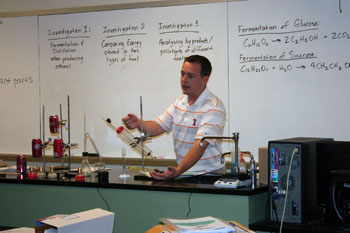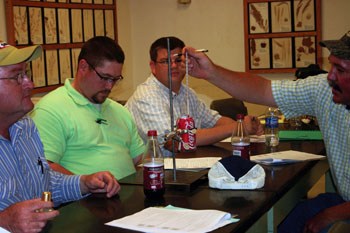
OSU STEM Institute Offers Alternative Energy Track


A new sprout
The ninth annual Science, Technology, Engineering, and Mathematics (STEM) Institute Training was held June 1 – 2, 2011, on the Oklahoma State University campus in Stillwater, Okla.
Traditionally, participants have the opportunity to learn about global positioning systems (GPS), iGreen (natural resource management), robotics, precision agriculture, digital photography, and videography. But this year, alternative energy made its debut at the STEM Institute.
Shane Robinson, associate professor of agricultural education at OSU, guided this first-year offering alternative energy track of the Institute.
Robinson’s goal was to attract Oklahoma’s secondary agricultural education teachers, county extension educators, and 4-H members and volunteers. Participants explored wind power, solar energy and biofuels; they also learned how to apply this knowledge in their schools and communities.
Robinson, plus agricultural education doctoral students Marshall Baker and Joey Blackburn, provided an introduction to alternative energy curriculum and the LAB-AIDS ethanol demonstration kit participants received.
According to Robinson, educators expressed an interest in learning about wind energy and other alternative power sources. “Through Ray Huhnke and EPSCoR, funds were secured to purchase science demonstration kits from LAB-AIDS that enabled educators to obtain hands-on experience regarding ethanol combustion," he added.
Jim Wicksted is the Associate Director of the Oklahoma Experimental Program to Stimulate Competitive Research (EPSCoR) and Principal Investigator for the NSF EPSCoR Research Infrastructure Improvement Award (EPS 0814361) to build Oklahoma’s leadership role in cellulosic bioenergy. Wicksted provided funding through this award for educational materials and demonstration kits. Huhnke, co-principal investigator for the NSF EPSCoR project and professor in biosystems and agricultural engineering at OSU, worked with Robinson and Wicksted to make this opportunity become a reality.
Each educator received access to more than $300 worth of educational materials. The materials included a LAB-AIDS demonstration kit on ethanol combustion; an alternative energy ball; and access to an electronic biofuels resource grid curriculum clearinghouse that they can use to teach their youth about alternative energy and biofuels.
P articipants also walked away with access to future online curriculum videos. “It is our intent to develop some short videos on using the demonstration kits beyond what was shared during the two-day in-service,” Robinson said. “It is also our hope to continue to develop curricular materials related to biofuels and alternative energy. As we accomplish these goals, we will upload them to the website that was shared with educators during the in-service.”
articipants also walked away with access to future online curriculum videos. “It is our intent to develop some short videos on using the demonstration kits beyond what was shared during the two-day in-service,” Robinson said. “It is also our hope to continue to develop curricular materials related to biofuels and alternative energy. As we accomplish these goals, we will upload them to the website that was shared with educators during the in-service.”
Robinson hopes that the alternative energy track will receive NSF funding again next year. “We intend to collect some qualitative data from the educators later this fall and report to EPSCoR the impact this professional development had on teachers’ use of the materials and information in which they were exposed,” he added.
OSU’s faculty working together to make it grow
Jeff Sallee, extension specialist for 4-H Youth Development, is responsible for incorporating STEM into the Oklahoma 4-H program.
He organized and facilitated the STEM Institute and the general educational plan that was implemented. “I rely on OSU faculty to teach the tracks based upon their specialties and interest,” Sallee said.
Scott Frazier, assistant professor of biosystems and agricultural engineering at OSU, educated the participants about wind and solar energy and provided wind tunnel demonstrations at the biosystems and agricultural engineering laboratory.
“Adult and young students were tasked to design and build their own wind turbine blades which were then tested in a competition to see which design generated the most power,” Frazier said.
Part of his position in the BAE department includes conducting several outreach classes every year that focus on the areas of engineering and science using renewable energy.
Frazier built a portable energy classroom in the Renewable Energy Demonstration Trailer. “I am currently demonstrating the trailer and doing durability tests,” he said. “We are developing teaching materials and programs for this portable education device so that various groups can have access to the science and technology learning opportunities in Oklahoma.”
Sarah Lancaster, assistant professor of plant and soil sciences at OSU, talked with the participants about the production of starch based (corn), cellulosic (switchgrass), and lipid (algae) alternative energy sources.
Participants also visited with research faculty working in renewable bioenergy. Faculty from the biosystems and agricultural engineering department included Nurhan Dunford, Hasan Atiyeh and Ajay Kumar; Gopal Kakani also represented the plant and soil sciences department.
“Working with youth in activities like this can be rewarding and energizing for faculty,” Lancaster said. “It’s exciting to see the potential that interested students possess!”
She has worked with Sallee on projects in the past. Lancaster, Sallee, Robinson and Frazier agreed that an alternative energy track would be a great addition to the STEM Institute.
Sowing the seed
 Arnold Bourne, agricultural education instructor at Durant High School, has already used wind and solar energy curriculum in his classrooms. “I am excited about these new technologies and eager to learn more and share with the students,” he said.
Arnold Bourne, agricultural education instructor at Durant High School, has already used wind and solar energy curriculum in his classrooms. “I am excited about these new technologies and eager to learn more and share with the students,” he said.
He plans to use the ethanol demonstration kit and experiments provided at the training. Bourne said this will be an ideal fit for his natural resources class, offered to juniors and seniors, and he may introduce the subject in his introductory agriculture class.
Bourne hopes that creating this excitement will inspire students to become engaged in this area of study. “I think they will be excited about these possible future solutions,” he said.
Bourne is very appreciative of OSU’s hospitality for this training opportunity. “It was great to be at the university and see the scientist show their work, the crops grown in the field, see how algae is harvested, and actually see where and how researchers are processing plant material into forms of fuel. This type of demonstration is important to our state and our nation.”
Nurturing the seed
 “In the end, this in-service provided advocacy, literacy, and awareness to individuals who are deemed ‘change agents’ in their home communities,” Robinson said.
“In the end, this in-service provided advocacy, literacy, and awareness to individuals who are deemed ‘change agents’ in their home communities,” Robinson said.
Lancaster, Sallee, Robinson and Frazier believe it is necessary to continue supporting these types of learning activities so students have the core fundamentals necessary to expand their knowledge and reach their educational goals.
“In my opinion, agriculture and alternative energy provide a great structure for accomplishing those important goals,” Lancaster said. “By developing students with strong science skills, Oklahoma will be well-positioned to solve some of the challenges that will arise as our society is forced to become less dependent on petroleum-based sources of energy. This has the potential to provide tremendous economic opportunity for our state. Activities like the STEM Institute play a role in encouraging students to pursue education and careers in science by giving them hands-on experiences.”
Back to the STEM
The STEM Education Coalition is a national effort that represents the broadest and most unified voice in advocating for policies to improve STEM education at all levels.
Each county was invited to send a youth-adult team to attend Oklahoma’s STEM Institute training to participate in research and address community issues and projects relevant to youth development.
According to Sallee, the attendees typically partner with local organizations such as their fire department, historical society, 4-H, or NRCS to apply what they learned and complete their projects. This allows participants to see firsthand how their efforts have impacted society and initiated change within the community.
For more information about Oklahoma 4-H and STEM opportunities, please visit the Oklahoma 4-H website at
http://oklahoma4h.okstate.edu/.
Department of Agricultural Education,
Communications and Leadership
http://aged.okstate.edu/
Department of Biosystems and
Agricultural Engineering
http://biosystems.okstate.edu/
Department of Plant and Soil Sciences
http://pss.okstate.edu//
OSU Biobased Products and Energy Center
http://bioenergycenter.okstate.edu/
Written by Amanda Erichsen, Extension Assistant | Biosystems and Agricultural Engineering | Oklahoma State University | 218 B Agricultural Hall, Stillwater, OK 74078-6016 | [email protected] | Phone: 405-744-2398
Photos and graphics courtesy of OSU Agricultural Communication Services and the OSU Department of Agricultural Education, Communications and Leadership.
Oklahoma State University, U.S. Department of Agriculture, State and Local Governments Cooperating: The Oklahoma Cooperative Extension Service offers its programs to all eligible persons regardless of race, color, national origin, religion, gender, age, disability, or status as a veteran, and is an equal opportunity employer.
Any opinions, findings, and conclusions or recommendations expressed in this material are those of the author(s) and do not necessarily reflect the views of the National Science Foundation.
